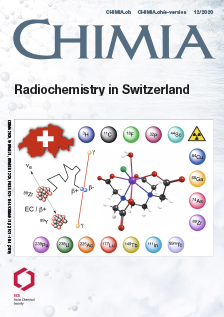The Metamorphosis of Radionuclide Production and Development at Paul Scherrer Institute
DOI:
https://doi.org/10.2533/chimia.2020.968PMID:
33357290Keywords:
History of science, Radiochemistry, Radionuclide development, Radionuclide production, RadiopharmacyAbstract
Radionuclide production and development has a long history at the Paul Scherrer Institute (PSI) and dates back to the founding times of its forerunner institutions: the Federal Institute for Reactor Research and the Swiss Institute for Nuclear Research. The facilities used for this purpose have evolved substantially over the last five decades. Many radiometals in use today, as radiopharmaceuticals, are for the diagnosis and treatment of disease, with the most popular means of detection being Positron Emission Tomography. These positron emitters are easily produced at low proton energies using medical cyclotrons, however, developments at these facilities are lacking. Currently, the fixed 72 MeV proton beam at PSI is degraded at IP2 irradiation station to provide the desired energy to irradiate targets to produce the likes of 44Sc, 43Sc and 64Cu as a proof of principle, which are of great interest to the nuclear medicine community. This development work can then be implemented at facilities containing medical cyclotrons. A history of the development of radionuclides at PSI, along with current development and projects with partner institutions, is described.Downloads
Published
2020-12-23
Issue
Section
Scientific Articles
License
Copyright (c) 2020 P. V. Grundler, R. Eichler, Z. Talip, P. A. Schubiger, R. Schibli, N. P. van der Meulen

This work is licensed under a Creative Commons Attribution-NonCommercial 4.0 International License.
How to Cite
[1]
P. V. Grundler, R. Eichler, Z. Talip, P. A. Schubiger, R. Schibli, N. P. van der Meulen, Chimia 2020, 74, 968, DOI: 10.2533/chimia.2020.968.







